The intersection of art and science has long been fertile terrain for visual representation. And, today in the drawings, paintings, and sketchbooks of artist Vesna Jovanovic one will find insightful, subtle, and preternatural commentary. Assimilating her ongoing studies in art and science, Jovanovic raises questions surrounding scientific representation, empiricism, and subjectivity with a focus on the human body. This week the COMP Magazine ran over to Jovanovic’s East Garfield Park studio to have a chat about the transitory nature of the body, her research process and execution of artworks, her role as an educator, and her upcoming residency in the south of France.
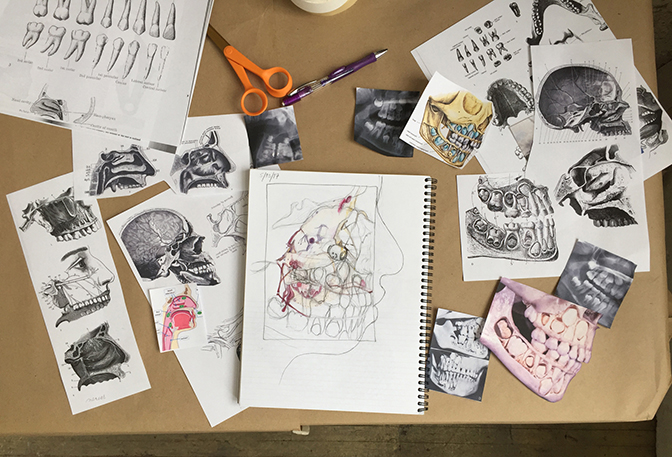
Vesna Jovanovic, references and sketchbook, 2018
You have a background in the sciences in addition to extended studies in the fine arts. I see a clear relevance in how these experiences clearly define your aesthetic investigations. I’m wondering if we can begin with you identifying any items from your youth that you see informing your present practice?
I am very much interested in scientific representation, perception, and subjectivity/objectivity. I think that my work is focused on these ideas because I simultaneously pursued both fields—art and science—and observed differences in attitude and approach to similar subjects. I find it really interesting that the two fields can exist within the same cultural moment while approaching knowledge with such different methodologies. My current work in painting and drawing is more directly influenced by a class I took with Barbara Rossi as an undergraduate at SAIC. This was many years ago, but the remnants of that influential time are still with me. She asked us to create something resembling a Rorschach test and to draw directly on top of the inkblot. My mind immediately went to images of laboratory glassware; I was working in research laboratories at the time. As I developed the work over several years, with each drawing the images became more and more organic and now somewhat resemble human anatomy and medical illustration. This turn led to an interest in philosophy and theory of the human body.
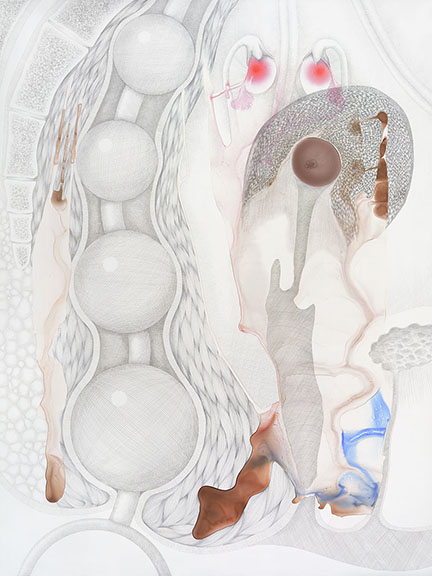
Vesna Jovanovic, Anal Beads, ink and graphite on polypropylene, 80″ x 60″, 2016
You synthesize personal experience with research you compile in your sketchbooks. Can you discuss this process? Where do you see these various activities intersecting and culminating into the production of your drawings and paintings?
I tend to feel overwhelmed by the potential of a blank canvas, so I rely on chance operations to get me started. Unless I have a specific conceptual direction in mind for a piece, I usually begin with randomly spilled ink as a visual prompt. This part of my practice stands in contrast to the meticulous cross-hatching and illustrating that is typical of hand-rendered medical illustration, which I also include in my work. In order to bring these things together, I often plan my work by creating a small sketch of the abstract ink shapes and then superimposing other visual possibilities through collage and more sketching. I use my sketchbook to synthesize ideas and to keep track of visual experiments. In a way it’s like a laboratory notebook.
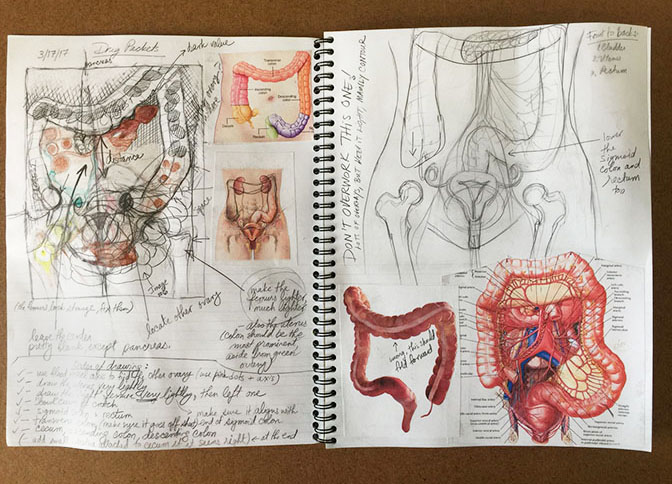
Vesna Jovanovic, sketchbook, 2018
The body is complex, constantly changing. This is central to your practice. In addition, I see variables of chance playing out in your conceptual and tactile approach. Can you share with us how you think about and work through a painting?
What drives my practice is the idea that embodied life cannot be visually represented. There are things that can only be experienced firsthand, such as pain, hunger, love. Most of my work hinges on this idea. This is why I am so drawn to medical illustration from a philosophical standpoint. As an attempt to objectively represent the human body, medical illustration lacks so much of what having or being a body is about.
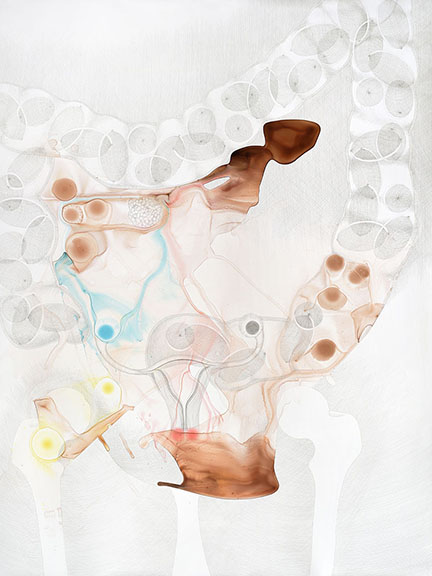
Vesna Jovanovic, Drug Packets, ink and graphite on polypropylene, 80″ x 60″, 2017
Lets talk about the series Foreign Bodies. In these artworks I see recognizable items (beads, organs, and skeletal framework) coupled with illusory fields of organized abstraction. What was the impetus for this series? Can you discuss the intent of this work?
Foreign Bodies began with a question: where is the threshold between the body and the non-body, i.e. the other? Conventionally we think of the body as ending with the surface of the skin. But this gets complicated. For example, our microbiome outnumbers our own cells yet protects us and helps us digest food. Why do we consider it distinctly non-human? I began thinking about surgically implanted things like pacemakers, bone screws, breast implants… even eyeglasses, walking canes, cars, guitars, living spaces—things traditionally outside of us or separate from us. All of these things affect us viscerally. They can be seen as extensions of the body, especially if they have functions that appear similar to those of limbs, eyes, etc. I began drawing all of the different examples and problems that came to mind, and that propelled the work. I decided to use flesh-colored ink to render tissue—this is the more abstract part. Then I use graphite pencils for cross-hatching and detailing the inserted foreign body in question. Ironically the human tissue in these paintings looks a lot more foreign than the inserted foreign body. The work addresses the notion of “othering” in general. I think it’s relevant even concerning attitudes towards immigrants and refugees. I find a lot to think about in this work.
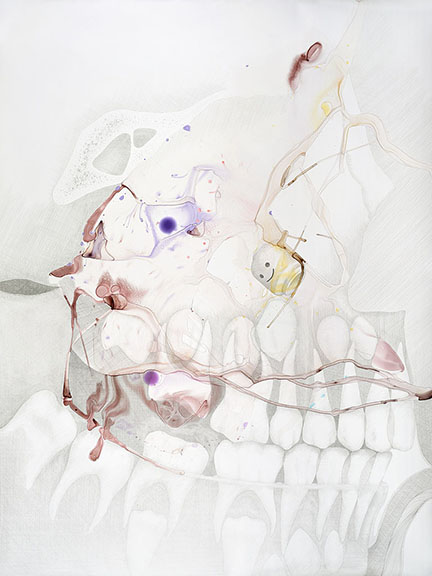
Vesna Jovanovic, Plastic Toy Part, ink and graphite on polypropylene, 80″ x 60″, 2017
What do you value most in your artistic practice?
I value many things: the opportunity to meditate in an activity, the problem-solving, the social nature of innovation in the field. But in the end I am most excited by my practice as an excuse to contemplate subjects deeply in ways that no other field would allow. Art does not have some of the methodological restrictions of other fields. That is not to say that there are no rules. But there are many ways to enter the stream of inquiry and it is a very social field. Having studied and worked in science, I must say that making good art has been much more challenging—and I love tackling a challenge.
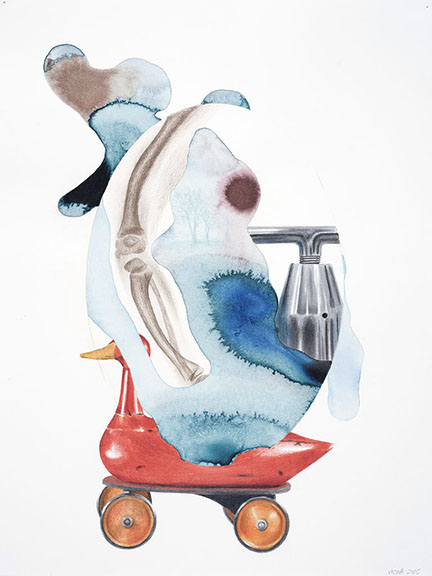
Vesna Jovanovic, Lucy V., ink and colored pencil on paper, 16″ x 12″, 2015
In addition to your studio practice, you teach. Are there any ongoing items you share with your students?
I enjoy guiding students to discover what is most significant to them. I don’t want to transfer my own formal and conceptual interests. I am more invested in teaching students how to recognize important moments, how to work with mistakes, how to notice the difference between trite and meaningful formal choices… stuff like that. A lot of what I teach was passed down to me during my own studies. For example, when I was a student in Barbara Rossi’s class she once said that “drawings never lie.” That made a lot of sense in context of what was happening in the classroom at the time. It taught me just how much information the form of a drawing can carry beyond the subject matter. On another occasion—this was in grad school—I remember feeling uninspired and jaded in my studio. Ann Hamilton came by and said: “Waiting is an active thing.” In other words, one must have their hands in the material in order to become inspired. That moment significantly changed how I approach my practice. These are the kinds of wisdoms I strive to pass on to my students.
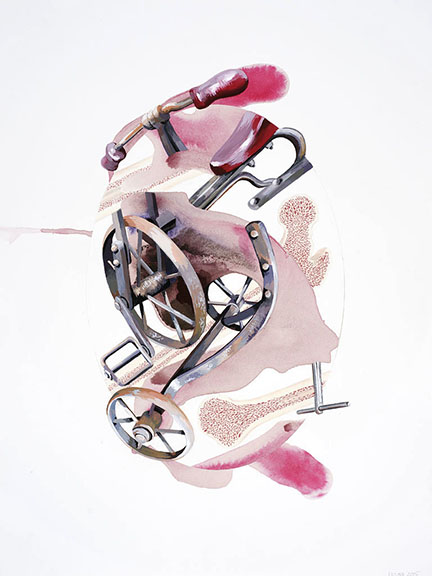
Vesna Jovanovic, Lizzie H., ink, gouache, and colored pencil on paper, 16″ x 12″, 2015
During my visit, you were preparing for upcoming exhibitions, a residency in the south of France, and in-process of moving your studio. What type of preparation is underway? What else do you have planned for the remainder of 2018?
Ah, the usual. Packaging work, contacting people, trying to make more work in the midst of all of it… The frenzy never ends. Except now I also need to learn French.
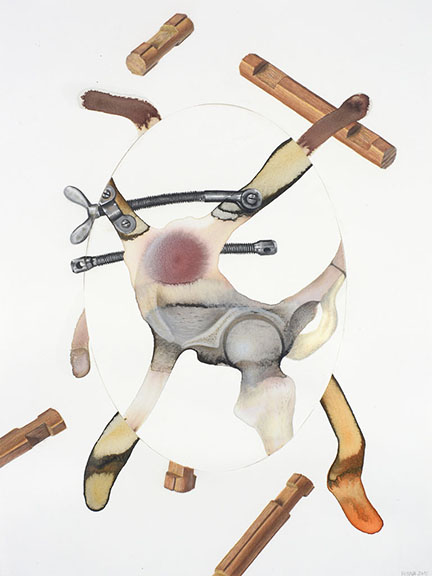
Vesna Jovanovic, Harold S., ink and colored pencil on paper, 16″ x 12″, 2015
For additional information on the art practice of Vesna Jovanovic, please visit:
Vesna Jovanovic – http://www.vesnaonline.com/
New City – https://art.newcity.com/2015/01/31/portrait-of-the-artist-vesna-jovanovic/
MedinArt- http://www.medinart.eu/works/vesna-jovanovic/
Santa Fe Art Institute – https://sfai.org/residents/vesnajovanovic/
Bad at Sports – http://badatsports.com/2016/episode-540-vesna-jovanovic/
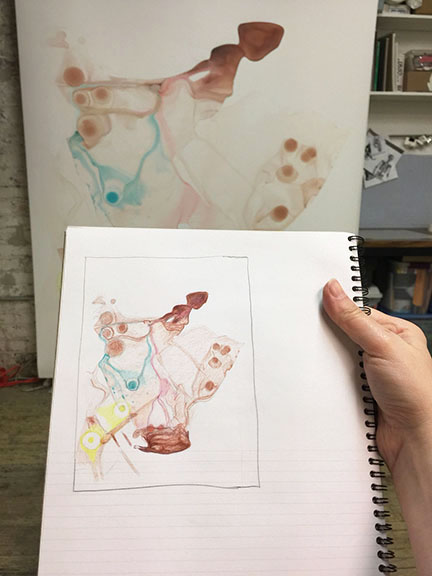
Vesna Jovanovic, sketchbook, 2018
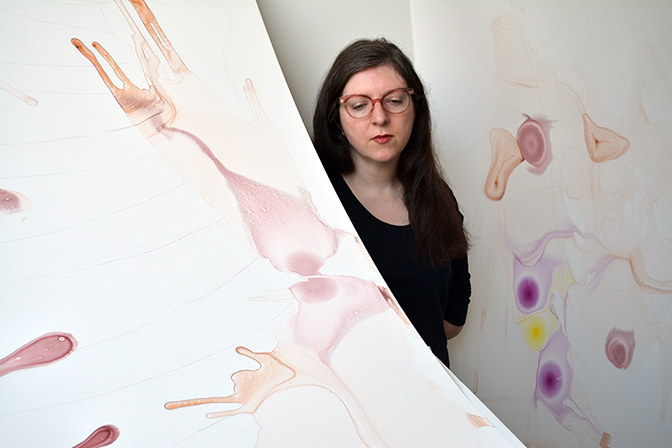
Painter Vesna Jovanovic in her East Garfield Park studio, Chicago, 2018
Artist interview and portrait by Chester Alamo-Costello


